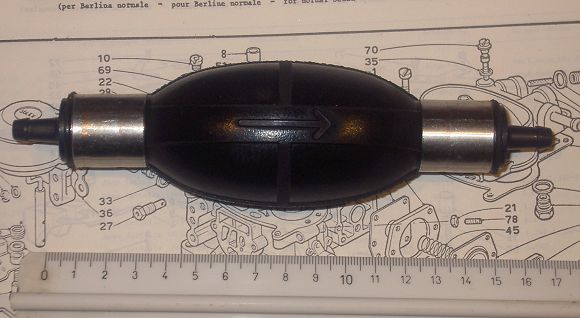Electric fuel pump
Posted: 10 Oct 2004, 23:06
In response to a question I received by email about installing an electric fuel pump on a Fulvia to prime the carbs.
In general I don't like an electric fuel pump on a Fulvia. Several reasons.
The mechanical pump is simpel, quite capable of doing the job and it gives the right pressure (0,35 bar) for the Solexes. Dellorto's will also run fine on this pressure although some say they like a bit lower pressure better. I have measured several different pumps on different Fulvia's and the pressure was exactly right on al of them and remained constant over the rev range. After almost 40 years many Fulvia's still run on their original mechanical fuel pumps. Name me one electrical fuel pump which has the same reliability.
If priming takes too long, there might be another cause such as dirty fuel filters or fuel lines or dirt in the fuel pump. My Fulvia's hardly take longer than 20 seconds of priming after many weeks of not being used. Installing an electric pump may mask potential problems such as completely blocked fuels lines / filters, bad starter motor, insufficiently charged battery, voltage regulator going bad. Better fix these potential problems first and then think again.
The disadvantages of an electric fuel pump are:
- it continues pumping after an accident if the engine is not switched off
- it draws current and thus reduces range in case of a dynamo / alternator failure.
- it unnecessarily loads V-belt, pulleys and dynamo / alternator
- it may flood carbs
A simpel device for priming the carbs is a handpump as used with outboard engines. It looks like a rubber ball and is connected in the fuel line. Squeeze the ball a couple fo times before turning the key. You have to open the bonnet anyway to check oil and water.
If you still want an electric pump, then connect it in parallel with the mechanical pump using T-pieces and operate it through a switch on the dashboard. Feed the switch from the "yellow circuit" which carries 12 volts when the key is turned 90 degrees (and 180 degrees). Switch off the pump when the engine runs. Since I often forget to turn off switches, I would connect it to the same wire that operates the startermotor. It will take a bit longer to prime the carbs than when operated through a seperate switch but it is safer.
In general I don't like an electric fuel pump on a Fulvia. Several reasons.
The mechanical pump is simpel, quite capable of doing the job and it gives the right pressure (0,35 bar) for the Solexes. Dellorto's will also run fine on this pressure although some say they like a bit lower pressure better. I have measured several different pumps on different Fulvia's and the pressure was exactly right on al of them and remained constant over the rev range. After almost 40 years many Fulvia's still run on their original mechanical fuel pumps. Name me one electrical fuel pump which has the same reliability.
If priming takes too long, there might be another cause such as dirty fuel filters or fuel lines or dirt in the fuel pump. My Fulvia's hardly take longer than 20 seconds of priming after many weeks of not being used. Installing an electric pump may mask potential problems such as completely blocked fuels lines / filters, bad starter motor, insufficiently charged battery, voltage regulator going bad. Better fix these potential problems first and then think again.
The disadvantages of an electric fuel pump are:
- it continues pumping after an accident if the engine is not switched off
- it draws current and thus reduces range in case of a dynamo / alternator failure.
- it unnecessarily loads V-belt, pulleys and dynamo / alternator
- it may flood carbs
A simpel device for priming the carbs is a handpump as used with outboard engines. It looks like a rubber ball and is connected in the fuel line. Squeeze the ball a couple fo times before turning the key. You have to open the bonnet anyway to check oil and water.
If you still want an electric pump, then connect it in parallel with the mechanical pump using T-pieces and operate it through a switch on the dashboard. Feed the switch from the "yellow circuit" which carries 12 volts when the key is turned 90 degrees (and 180 degrees). Switch off the pump when the engine runs. Since I often forget to turn off switches, I would connect it to the same wire that operates the startermotor. It will take a bit longer to prime the carbs than when operated through a seperate switch but it is safer.
